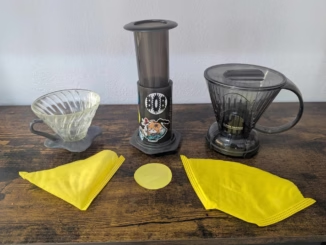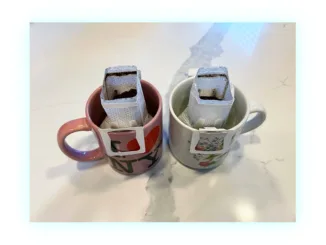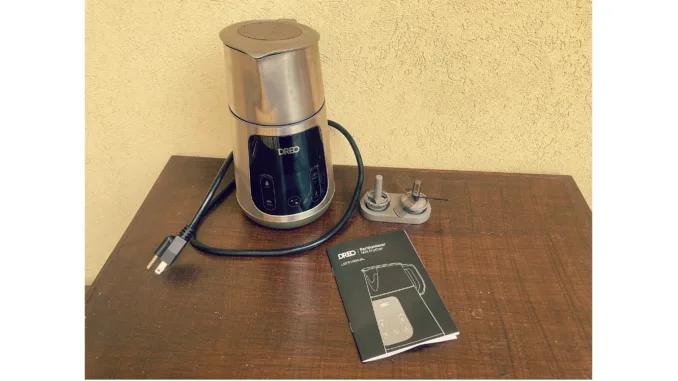
I had the chance to be among the first to try the new BaristaMaker Milk Frother produced by DREO; here’s how it went.
BY TANYA NANETTI
SENIOR ONLINE CORRESPONDENT
Photos by Tanya Nanetti
One of the things I missed most in the days and weeks when I wasn’t working behind a professional espresso machine was the ability to drink a delicious flat white. Sure, I could always get to my favorite café, but a daily visit to a café could become too dangerous for my wallet. So I often drank something like an old-school caffe latte at home, which here in Italy is a simple cup of hot milk mixed with a little coffee from my old Moka pot.
Things finally changed a couple of weeks ago, when I had the chance to test drive the new BaristaMaker Milk Frother produced by DREO, a brand specializing in smart home innovation. Their milk frother is designed to work with different types of milk, creating a perfect micro-foam similar to the one made with high-pressure steam wands by specialty-coffee baristas around the world.
About the DREO BaristaMaker
While I’m waiting for my BaristaMaker, I contact Joshua Gunn, VP for North America at DREO, to learn more about what to expect from the frother.
“When we designed the DREO BaristaMaker milk frother, we focused on three key target groups: experienced baristas, coffee enthusiasts, and casual coffee consumers,” Joshua says. “For experienced baristas, we wanted to create a device that met their high standards, allowing them to replicate the quality of café-style froth at home. For coffee enthusiasts, people with a deep passion for coffee who are always looking for ways to improve their brewing experience, we wanted to provide a tool to create the perfect microfoam that they so much appreciate. We also kept in mind the broader audience of casual coffee drinkers who appreciate well-made coffee but may not have the skills or tools of a professional. Our goal was to provide them with a simple but effective way to elevate their daily experience with coffee.”
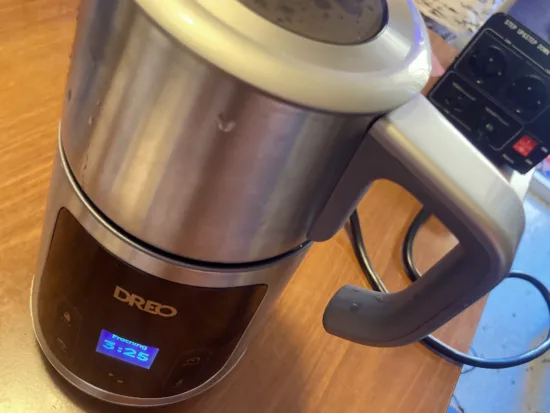
Then, Joshua goes on to explain why BaristaMaker will revolutionize the world of milk frothing for home baristas, thanks to its strongest suits. It has “the industry’s first barista-level frothing tip (a disruptive hardware innovation created by the DREO lab’s food scientist by combining two new components into a single structure, making the new patented Barista Combo technology the first to achieve barista-level results on the household frother category); the impeller blade design (capable of guiding the flow of milk, drawing it consistently to the center for incredibly uniform froth, unlike traditional disc tips that produce uneven froth); and the uniquely designed micro-level screen (capable of filtering and transforming normal-sized bubbles into rich, dense micro-foam during the multi-stage frothing process).”
Excited by Joshua’s promise and by the unique opportunity to try the BaristaMaker, I visit my local market to stock up on a few liters of dairy and nondairy milk, buy a new bag of beans to work with my (cheap) espresso machine, and get ready to start playing with my new milk frother.
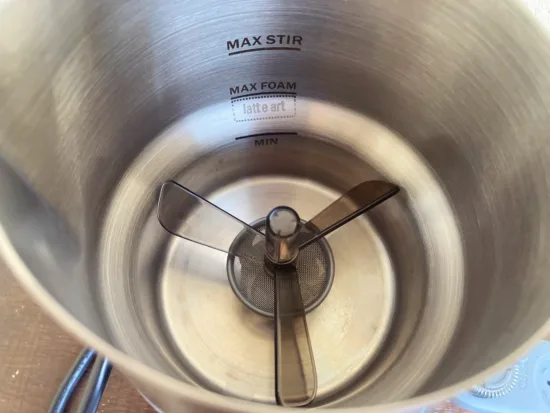
Unpacking, Assembly, and Options
As soon as I unpack the BaristaMaker DREO milk frother, I realize what a sleek and elegant coffee tool it is, with a compact design perfect for the most fashionable modern kitchens. The milk frother comes with a disc tip, two impeller tips, and a tip holder. Assembly is a simple and smooth operation: just rinse all the parts and choose between the two included tips, remembering that the impeller tip is perfect for micro-foam, while the disc tip is suggested for cold foam and stirring.
Once assembled, I simply plug the milk frother into a 110V-120V power outlet. The LEDs on the display panel light up and I’m able to choose the desired settings through the simple interface.
Available options include milk, half-and-half, almond, oat, soy, and coconut for milk types; hot cappuccino, latte, and flat white as latte art coffee; and cold and hot frothed foam. You can select low or high speed, and temperatures ranging from cold to 170°F (about 75°C, a bit higher than my usual milk-steaming temperature) for stirring non-foamed drinks.
Steaming Milk
After selecting the preferred settings, I insert the right tip (as suggested by the BaristaMaker) before pouring the milk into the jug following the internal marks (min – latte art – max foam – max stir) and pressing the start button. The milk will be ready in about three and a half minutes, punctuated by a useful countdown timer that allows users to perfectly time their espresso shots with the end of frothing. Once the milk is ready, it’s time to pour. The BaristaMaker jug works perfectly, thanks to its shape and precise spout that mimics a professional stainless-steel pitcher.
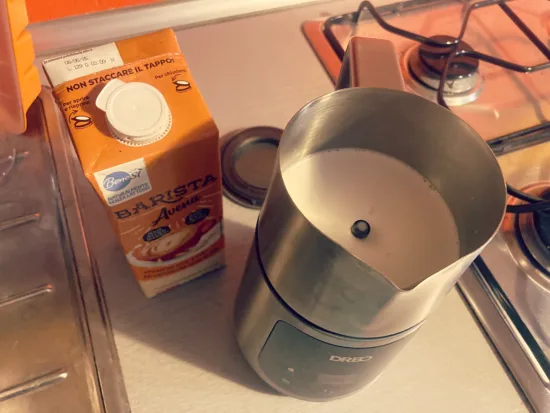
Pour Test
I proceed to pour with my usual routine: a gentle tap to remove excess bubbles, and a circular motion to keep the milk compact and avoid separation. Then I immediately pour the milk into my espresso.
The micro-foam is shiny and smooth, similar to what I can achieve with the wand of a professional espresso machine. Pouring is easy, and it only takes me a second to realize that if only I had a better espresso machine that actually made some crema on top of the espresso, the flat white I am pouring would be just perfect.
For the first few mornings, I focus my frothing routine on “latte art” coffees, experimenting with lattes, cappuccinos, and flat whites, marveling at how it is possible for a “simple” milk frother to be able to produce such a pleasant micro-foam.
As the DREO leaflet explains, there are a few steps behind this magic.
First, the milk is heated quickly to reach the right temperature (which, by specialty-coffee standards, is around 160°-170°F). Then, the speed of rotation increases by incorporating air into the milk so as to create larger bubbles. Finally, as the speed slows down, the impeller directs the foam toward the center, turning it into silky micro-foam.
From the description, it sounds like an accurate replica of professional milk steaming, and the resulting micro-foam is exactly that.
Happy with my micro-foam, it’s time to experiment with BaristaMaker’s other features.

Trying Other Drinks
First, I decide to make a chai latte, and the procedure is even smoother. After switching to the disc tip, I add the milk, then the chai powder, then select the low speed and temperature of 170°C as suggested, and start stirring.
After a few minutes, a perfectly blended chai is ready to be sipped.
On the next hot afternoon, I try the cold thick foam setting to make an iced cappuccino.
Again, I insert the disc tip and start frothing my barista-grade almond milk. The resulting foam is fluffy and delicious, and once a double espresso is poured, it stays fluffy until my boyfriend finishes drinking it.
Next I try out non-homogenized whole dairy milk, even though I already have an idea of what will happen. As is the case also in a professional environment, the whole milk’s high level of fat molecules will surely get in the way, and I’m pretty sure the foam won’t be as fluffy.
After overwhelming confirmation (whole milk makes a good foam, but it completely un-foams within seconds), I replicate the experiment with skim milk, which tastes worse but foams much better.
I spend the rest of the week experimenting with all the different functions of the BaristaMaker until I am ready to make some considerations.

The Takeaway On the DREO BaristaMaker Test Drive
The BaristaMaker is super easy to set up and use. It works well with all types of dairy milk and many barista-grade alternative milks, and it stirs and foams easily. The micro-foam is the closest to a professional foam that I have been able to achieve outside of a café, and the resulting drinks are perfectly creamy and delicious.
The minimum amount of milk to froth—following the marks inside the jug—is enough for a milky drink of about eight to nine ounces (which is an average latte in most European countries, but can be different elsewhere). In my experience, selecting the flat white from the menu will result in a really silky, fine micro-foam, which will become a little frothier when the latte setting is selected, and even fluffier and creamier when opting for the cappuccino mode.
Moreover, the maintenance of the BaristaMaker is straightforward: The jug, lid, and tips can simply be washed in hot soapy water, or even in the dishwasher.
In conclusion, as promised, the BaristaMaker produces perfect micro-foam that, if I had a better espresso machine, would have been perfect for more complicated latte art patterns. Now that I have a perfectly efficient milk frother, I just need to upgrade my espresso machine. Then I will be able to prepare a milk drink at home exactly like at the café!
ABOUT THE AUTHOR
Tanya Nanetti (she/her) is a specialty-coffee barista, a traveler, and a dreamer. When she’s not behind the coffee machine (or visiting some hidden corner of the world), she’s busy writing for Coffee Insurrection, a website about specialty coffee that she’s creating along with her boyfriend.
Subscribe and More!
Out now: It’s the August + September 2024 issue of Barista Magazine! Read it for free with our digital edition. And for more than three years’ worth of issues, visit our digital edition archives here.
You can order a hard copy of the magazine through our online store here, or start a subscription for one year or two.



